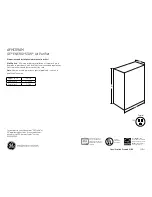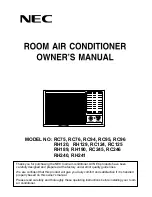
.REFRIGERANT PIPING WORK (3/5)
)
<Please refer to installation manual of indoor
unit about indoor unit's refrigerant piping>
�-5 REFRIGERANT PIPING WORK)
• The refrigerant piping is connectable in four directions. (See Fig. 4)
• Do not let anything other than the designated refrigerant ( such as air or water ) enter the refrigerant system.
• When connecting in a downward direction, open the knock out hole by making 4 round holes around the
knock out hole by using a 6mm drill. (see Fig.5)
• Cutting out the two slits makes it possible to install as shown in Fig. 6 (Use metal saw to cut out the slits)
Screw for
front plate
Front plate
Screw for
front late
Piping outlet
plate (front)
Drill
Center area around
knock hole
0�
IBackwardl
Piping outlet
plate (rear)
Connection piping
Piping outlet
plate screw
ISideward I
Fig. 4
Slit
Bottom frame
Fig. 5
Fig.6
•After knocking out the knock hole, it is recommended to apply repair paint to the edge and the surrounding
end surfaces to prevent rusting.
(Back side (rear) connection) Remove the piping outlet plate
(rear) for connection.
Flare nut
Piping (gas)
(field supply)
Flare nut
Piping (liquid)
(field supply)
( Side (lateral) connection
Flare nut
Piping (gas)
(field supply)
�
Prevention against small animals entering into the casing
Fill up the space with putty or thermal insulation(field supply)
CAUTION Where the piping through as shown in Fig. 7.
(If small animals touch the electrical parts inside, this may cause malfunction,
smoke or fire.)
(PRECAUTIONS WHEN THE HANDLING PIPING STOP VALVES)
) Remove the piping outlet plate
(front) for connection.
Piping (liquid)
(field supply)
Putty or
thermal insulation
(field supply)
Fig. 7
Service port
loo NOT OPEN THE STOP VALVE UNTIL THE
&
CHARGING THE REFRIGERANl)FINISHEoj
The names of the parts necessary for handling the piping stop valves for the indoor and
outdoor units are described in Fig. 8. The valves are closed before shipment.
When tightening the flare of the stop valves, make sure to tighten by the rated torque.
The rated torque is shown on(Precautions when tightening flare nuts)(following)
Applying force by exceeding the rated tightening torque may cause the sheet surface inside the
stop valve to twist, the refrigerant to leak inside the valve, and the flare nut to break.
Prohibited
Do not apply force to the valve cap or the valve body
when tightening the flare nut.
(It may cause refrigerant leakage due to deformation of
the valve body
• When using the low outdoor temperature cooling mode etc., the
pressure on the low pressure side might drop, so the flare nut on
the stop valves should be sealed completely with silicon sealant
or the like in order to prevent frost from forming on it (both gas
and liquid sides). (Refer to Fig. 9)
29
Fig.9
Valve bar
Valve cap
�o
Piping
connection
Fig. 8
Do not apply force to the valve
cap or the valve body
Silicon sealant
(make sure that
there is no gap)
Summary of Contents for FDMA125AV16
Page 22: ...4 15 3 30 RZA125AV16 RZA140AV16 RZA125AV16 RZA140AV16...
Page 50: ...49...
Page 51: ...50...
Page 52: ...51...
Page 53: ...52...
Page 54: ...53...
Page 55: ...54 49 48 49 50 50...
Page 56: ...55...
Page 58: ...MEMO...
Page 59: ...MEMO...
Page 60: ...MEMO 3P727715 6 B...















































